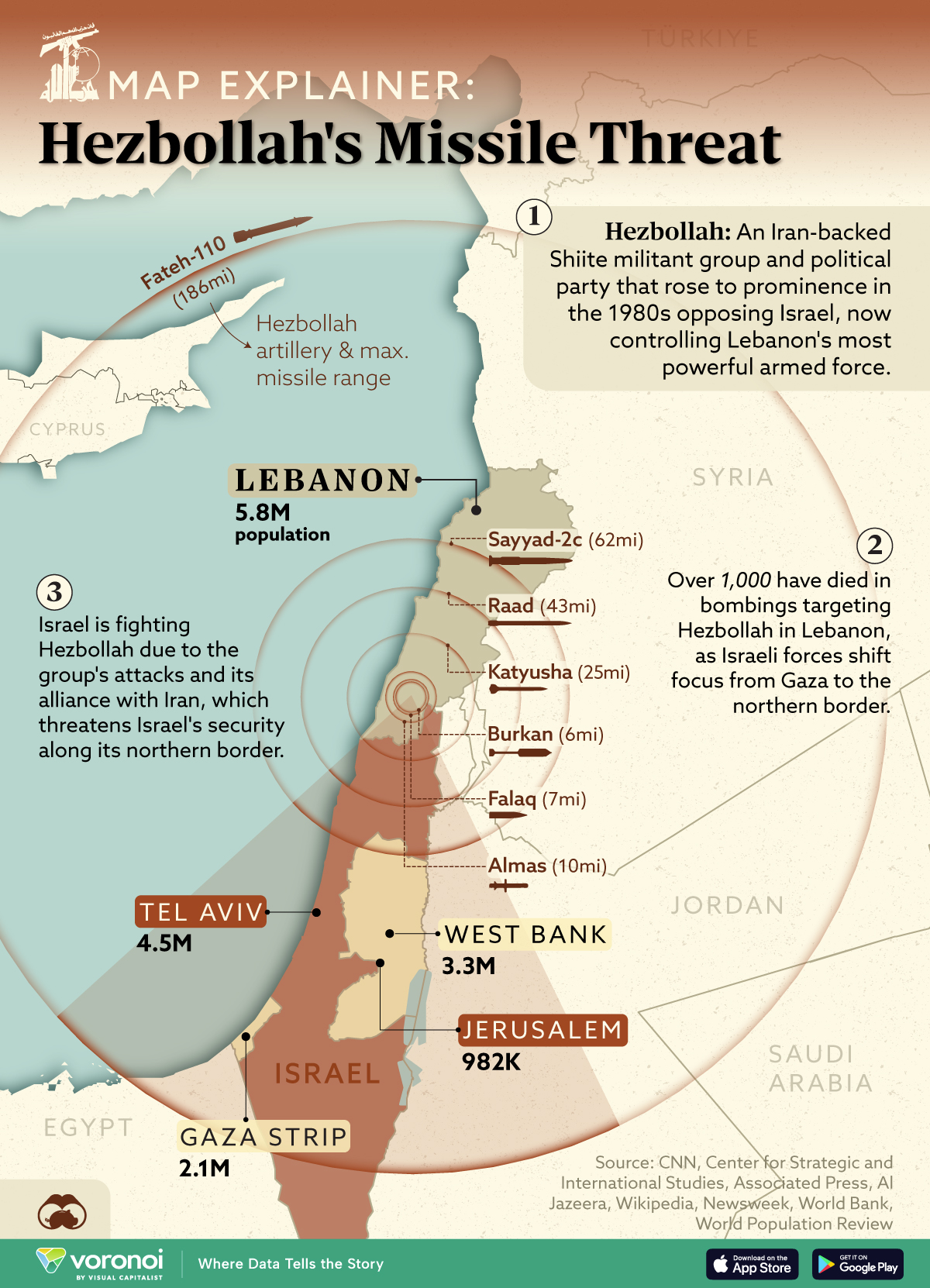![]()
See this visualization first on the Voronoi app.

Map Explainer: Hezbollah’s Missile Threat
This was originally posted on our Voronoi app. Download the app for free on iOS or Android and discover incredible data-driven charts from a variety of trusted sources.
In the past two weeks, more than 1,000 people have died, and 6,000 have been injured in Israeli attacks on Lebanon.
This map explores the Israel-Hezbollah conflict, focusing on Hezbollah’s military power.
What is Hezbollah?
Hezbollah is an Iran-backed Shiite Islamist militant group and political party that rose to prominence in the 1980s, initially opposing Israel. Today, it controls Lebanon’s most powerful armed forces. “Hezbollah” means “Party of God” in Arabic. In addition to its military operations, the group runs a network of public services, including clinics, schools, and a TV station.
Among Hezbollah’s arsenal are precision-guided missiles, like the Fateh-110, with a range capable of hitting big populated cities like Jerusalem and Tel Aviv.
| Hezbollah artilery and missile range | Max. range (in miles) |
|---|---|
| Fateh-110 | 186 |
| Sayyad-2c | 62 |
| Raad | 43 |
| Katyusha | 25 |
| Almas | 10 |
| Falaq | 7 |
| Burkan | 6 |
Israel, on the other hand, has the Iron Dome, a defense system designed to intercept and destroy short-range rockets and artillery shells.
Israeli Strikes Hit Hezbollah Commanders
Since the beginning of the conflict between Israel and Hamas in Gaza, Hezbollah has increased its involvement by firing rockets into northern Israel in support of Hamas.
Tensions escalated further in September, with Israeli attacks destroying thousands of Hezbollah’s wireless devices, resulting in dozens of deaths and thousands of injuries. An Israeli strike in Beirut killed senior Hezbollah commanders, followed by Israel’s largest bombardment of the war, which claimed over 500 lives in a single day.
Allied with Israel, the U.S. has deployed over 40,000 troops to the region, supported by the aircraft carriers USS Harry S. Truman and USS Abraham Lincoln in the Arabian Gulf.
Iran, meanwhile, has 1 million military personnel and possesses the largest missile arsenal in the Middle East. Iran has launched its own missile attacks on Israel throughout 2024, adding to existing tension in the region.
Timeline
- 1948: Lebanon joins Arab nations in the war against Israel; 100,000 Palestinian refugees arrive in Lebanon.
- 1967: Israel seizes the Golan Heights from Syria during the Six-Day War.
- 1968: The Palestine Liberation Organization (PLO) relocates to Lebanon.
- 1973: Israeli forces assassinate three Palestinian leaders in Beirut in response to the 1972 Munich Olympics attack.
- 1978: Israel invades southern Lebanon, targeting Palestinian guerrillas.
- 1982: Israel invades Lebanon up to Beirut; Iran’s Revolutionary Guards establish Hezbollah.
- 1983: Israel withdraws from central Lebanon but maintains forces in the south.
- 2000: Israel withdraws from southern Lebanon, ending 22 years of occupation.
- 2006: A five-week war results in over 1,200 deaths in Lebanon and 158 deaths in Israel.
- 2023: Hezbollah begins trading fire with Israel following Hamas attacks on southern Israel.
- 2024: Israel strikes have killed over 1,000 people in Lebanon; Iran launches missile attacks.
Lebanon
- GDP: $21 billion
- Population: 5.8 million
- Military: 60,000 active troops, 35,000 reserve forces, 65,000 paramilitary personnel
- Tanks: 204
- Aircraft: 45
Israel
- GDP: $510 billion
- Population: 9.4 million
- Military: 170,000 active troops, 465,000 reserve forces, 65,000 paramilitary personnel
- Tanks: 2,200+
- Aircraft: 339
Learn More on the Voronoi App ![]()
To learn more about this topic, check out this map that shows recognition of Israel by country.
The post Map Explainer: Hezbollah’s Missile Threat appeared first on Visual Capitalist.